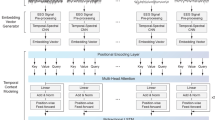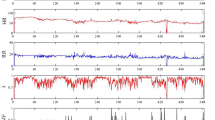Abstract
Neonatal sleep analysis at the neonatal intensive care units (NICU) is critical for the diagnosis of any brain growth risks during the early stages of life. In this paper, an investigation is carried out on the use of a long short-term memory (LSTM) learning system in automatic sleep stage scoring in neonates. The developed algorithm automatically classifies sleep stages based on inputs from a single channel EEG recording. Up to this date, only a single study have developed an approach for automatic sleep stage scoring in neonatal sleep signals using deep neural network (DNN). A total of 5095 sleep stages signals acquired from EEG recordings of the University of Pittsburgh are used in this study. The sleep stages are annotated by a medical doctor from the Pediatric Neurology Department of Case Western Reserve University for three neonatal sleep stages including the awake (W), active sleep (AS), and quiet sleep (QS) stages on every 60-s epoch. The signals are pre-processed through normalization and filtering. The resulted signals are divided following 4-, 6-, and 10-fold cross-validation schemes. The training and classification process is done using a bi-directional LSTM network classifier built with pre-defined training parameters. At the end, the developed algorithm is evaluated along with a complete summary table that reports the results of this study and other state-of-the-art studies. The current study achieved high levels of Cohen’s kappa (κ), accuracy, and F1 score with 91.37%, 96.81%, and 94.43%, respectively. Based on the confusion matrix, the overall true positives percentage reached 95.21%. The developed algorithm gave promising results in automatic sleep stage scoring in neonatal sleep signals. Future work include LSTM architecture and training parameters improvements to enhance the overall accuracy of the classifier.




Similar content being viewed by others
References
Ansari A, De Wel O, Lavanga M, Caicedo A, Dereymaeker A, Jansen K, Vervisch J, De Vos M, Naulaers G, Van Huffel S (2018) Quiet sleep detection in preterm infants using deep convolutional neural networks. J Neural Eng 15(6)
Dereymaeker A, Pillay K, Vervisch J, De Vos M, Van Huffel S, Jansen K, Naulaers G (2017) Review of sleep-EEG in preterm and term neonates. Early Hum Dev 113:87–103
Fraiwan L, Lweesy K, Khasawneh N, Fraiwan M, Wenz H, Dickhaus H (2011) Time frequency analysis for automated sleep stage identification in fullterm and preterm neonates. J Med Sys 35(4):693–702
American Academy of Sleep Medicine (AASM) (2018) Preterm newborns sleep better in NICU while hearing their mother’s voice. Internet. https://aasm.org/
Weisman O, Magori-Cohen R, Louzoun Y, Eidelman A I, Feldman R (2011) Sleep-wake transitions in premature neonates predict early development. Pediatrics 128:706–714
Levy J, Hassan F, Plegue M, Sokoloff M, Kushwaha J, Chervin R, Barks J, Shellhaas R (2017) Impact of hands-on care on infant sleep in the neonatal intensive care unit. Pediatr Pulmonol 52(1):84–90
dos Santos A, dos Santos R, Rocha G, Nunes M (2014) Behavior and EEG concordance of active and quiet sleep in preterm very low birth weight and full-term neonates at matched conceptional age. Early Human Development 90(9):507–510
Barbeau D, Weiss M (2017) Sleep disturbances in newborns. Children 4(10)
Schwabedal J, Sippel D, Brandt M, Bialonski S (2018) Automated classification of sleep stages and EEG artifacts in mice with deep learning. CoRR
Turnbull J, Loparo K, Johnson M, Scher M (2001) Automated detection of tracé alternant during sleep in healthy full-term neonates using discrete wavelet transform. Clin Neurophysiol 112(10):1893–1900
Lajnef T, Chaibi S, Ruby P, Aguera P, Eichenlaub J, Samet M, Kachouri A, Jerbi K (2015) Learning machines and sleeping brains: automatic sleep stage classification using decision-tree multi-class support vector machines. J Neurosci Methods 250:94–105
De Wel O, Lavanga M, Dorado A C, Jansen K, Dereymaeker A, Naulaers G, Van Huffel S (2017) Complexity analysis of neonatal EEG using multiscale entropy: applications in brain maturation and sleep stage classification. Entropy 19(10):516
Dereymaeker A, Pillay K, Vervisch J, Van Huffel S, Naulaers G, Jansen K, De Vos M (2017) An automated quiet sleep detection approach in preterm infants as a gateway to assess brain maturation. Int J Neural Syst 27(6)
Fernández-Varela I, Hernández-Pereira E, Alvarez-Estevezy D, Moret-Bonillo V (2019) A convolutional network for sleep stages classification. arXiv:1902.05748
Supratak A, H Dong C W u, Guo Y (2017) DeepSleepNet: a model for automatic sleep stage scoring based on raw single-channel EEG. IEEE Trans Neural Sys Rehab Eng 25(11):1998–2008
Sors A, Bonnet S, Mirek S, Vercueil L, Payen J (2018) A convolutional neural network for sleep stage scoring from raw single-channel EEG. Biomedical Signal Processing and Control 42:107–114
Chambon S, Galtier M, Arnal P, Wainrib G, Gramfort A (2018) A deep learning architecture for temporal sleep stage classification using multivariate and multimodal time series. IEEE Trans Neural Sys Rehab Eng 26(4):758–769
Yildirim O, Baloglu U, Acharya U (2019) A deep learning model for automated sleep stages classification using PSG signals. International Journal of Environmental Research and Public Health 16(4)
Tsinalis O, Matthews P, Guo Y (2016) Automatic sleep stage scoring using time-frequency analysis and stacked sparse autoencoders. Ann Biomed Eng 44(5):1587–1597
Dong H, Supratak A, W Pan C W u, Matthews P, Guo Y (2018) Mixed neural network approach for temporal sleep stage classification. IEEE Trans Neural Sys Rehab Eng 26(2):324–333
Phan H, Andreotti F, Cooray N, Chen O, De Vos M (2019) Joint classification and prediction CNN framework for automatic sleep stage classification. IEEE Trans Biomed Eng 66(5):1285–1296
Jozefowicz R, Zaremba W, Sutskever L (2015) An empirical exploration of recurrent network architectures. In: The 32nd International Conference on Machine Learning (ICML-15). Lille, France
Cui Z, Ke R, Wang Y (2018) Stacked bidirectional and unidirectional LSTM recurrent neural network for network-wide traffic speed prediction. arXiv:1801.02143
Sutskever I, Vinyals O, Le V (2014) Sequence to sequence learning with neural networks. In: Ghahramani Z, Welling M, Cortes C, Lawrence N D, Weinberger K Q (eds) Advances in neural information processing systems, vol 27. Curran Associates Inc., pp 3104–3112
Greff K, Srivastava R, Koutník J, Steunebrink B, Schmidhuber J (2015) LSTM: a search space odyssey. arXiv:1503.04069
Hochreiter S, Schmidhuber J (1997) Long short-term memory. Neural Comput 9(8):1735–1780
Fernandez R, Rendel A, Ramabhadran B, Hoory R (2014) Prosody contour prediction with long short-term memory, bi-directional, deep recurrent neural networks. In: INTERSPEECH
Graves A (2013) Generating sequences with recurrent neural networks. arXiv:1308.0850
Cui Z, Ke R, Wan Y (2018) Deep bidirectional and unidirectional LSTM recurrent neural network for network-wide traffic speed prediction. arXiv:180102143
Schuster M, Paliwal K (1997) Bidirectional recurrent neural networks. IEEE Transactions on Signal Processing 45(11):2673–2681. 10.1109/78.650093
Piryatinska A, Terdik G, Woyczynski W, Loparo K, Scher M, Zlotnik A (2009) Automated detection of neonate EEG sleep stages. Comput Methods Prog Biomed 95(1):31–46
M Aminian F, Aminian L, Schettinoand A (2010) Ameli (2010) Electroencephalogram (EEG) signal classification using neural networks with wavelet packet analysis, principal component analysis and data normalization as preprocessors. Proceedings of the Twenty-First MAICS, Midwest Artificial Intelligence
Alomari M, Samaha A, AlKamha K (2013) Automated classification of L/R hand movement EEG signals using advanced feature extraction and machine learning. arXiv:13122877
Yannick R, Banville H, Albuquerque I, Gramfort A, Falk T, Faubert J (2019) Deep learning-based electroencephalography analysis: a systematic review. arXiv:190105498
MATLAB (2019) Image processing toolbox. https://www.mathworks.com/products/signal.html
Savitzky A, Golay M (1964) Smoothing and differentiation of data by simplified least squares procedures. Analytical Chemistry 36(8):1627–1639
Schafer R (2011) What is a Savitzky-Golay filter. IEEE Signal Proc Mag 28(4):111–117
Acharya D, Rani A, Agarwal S, Singh V (2016) Application of adaptive Savitzky–Golay filter for EEG signal processing. Perspectives in science 8:677–679
Luo J, Ying K, Bai J (2005) Savitzky–Golay smoothing and differentiation filter for even number data. Signal processing 85(7):1429–1434
Kingma D, Ba J (2014) Adam: a method for stochastic optimization. arXiv:14126980
Cic M, Soda J, Bonkovic M (2013) Automatic classification of infant sleep based on instantaneous frequencies in a single-channel EEG signal. Comput Biol Med 43:2110–2117
Pillay K, Dereymaeker A, Jansen K, Naulaers G, van Huffel S, de Vos M (2018) Automated EEG sleep staging in the term-age baby using a generative modelling approach. J Neural Eng 15:1–13
Jeon Y, Kim S, Choi H, Chung Y, CHoi S, Kim H, Yoon S, Hwang H, Kim K (2019) Pediatric sleep stage classification using multi-domain hybrid neural networks. IEEE Access 7:96495–96505
Acknowledgments
This research is supported by Abu Dhabi University’s Office of Research and Sponsored Programs.
Author information
Authors and Affiliations
Corresponding author
Ethics declarations
Conflict of interest
The authors declare that they have no conflict of interest.
Additional information
Publisher’s note
Springer Nature remains neutral with regard to jurisdictional claims in published maps and institutional affiliations.
Rights and permissions
About this article
Cite this article
Fraiwan, L., Alkhodari, M. Neonatal sleep stage identification using long short-term memory learning system. Med Biol Eng Comput 58, 1383–1391 (2020). https://doi.org/10.1007/s11517-020-02169-x
Received:
Accepted:
Published:
Issue Date:
DOI: https://doi.org/10.1007/s11517-020-02169-x




